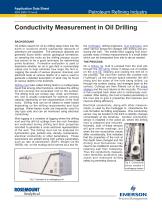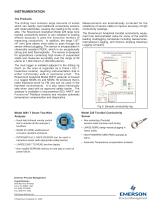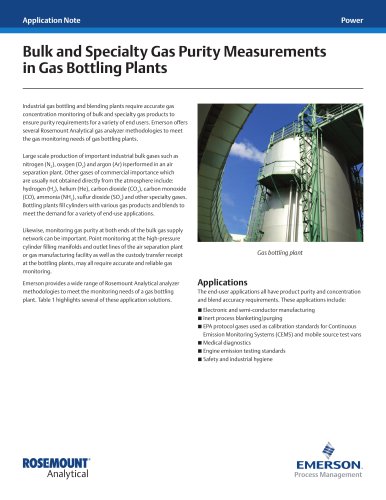
Excertos do catálogo

Application Data Sheet ADS 2900-11/rev.B July 2008 Petroleum Refining Industry Conductivity Measurement in Oil Drilling BACKGROUND Oil drillers search for oil by drilling deep holes into the earth in locations where substantial deposits of petroleum are expected. The petroleum deposits are generally found within certain geological formations, so sampling the rocks as the drilling process occurs has proven to be a good technique for determining prime locations. Formation evaluation is used to determine whether an oil or gas field is commercially viable and to help estimate how large the find is. Logging the results of various physical, chemical, and electrical tests at various depths of a well is used to generate a detailed description of what may be found at various depths in the borehole. Drilling mud (also called drilling fluid) is a multipurpose liquid that among other functions, lubricates the drilling bit and conveys the excavated rock to the surface. The drilling mud can contain clay, chalk, and thickeners, and is usually customized for optimum carrying capacity depending on the characteristics of the local rocks. Drilling mud can be oil based or water based depending on the drilling requirements and local geology. Water-based muds are frequently used for clay type soils and can be monitored using electrical conductivity. Mud logging is a variation of logging where the drilling mud and the drill bit cuttings from the rock formation are evaluated during drilling and their properties recorded to generate a cross sectional representation of the well. The drilling mud can be analyzed for hydrocarbon gas, particle size, density, temperature, electrical conductivity or other parameters. These parameters are plotted along with surface parameters such as rate of penetration (ROP), Weight On Bit (WOB), etc. on the mudlog which serves as a tool for the mudlogger, drilling engineers, mud engineers, and other service personnel charged with drilling and producing the well. The mobile Mud Logging Unit incorporates many of these measurements in a small trailer which can be transported from site to site as needed. THE PROCESS: On a drilling rig, mud is pumped from the mud pits through the drill string where it sprays out of nozzles on the drill bit, cleaning and cooling the drill bit in the process. The mud then carries the crushed rock ("cuttings") up the annular space between the drill string and the sides of the hole being drilled, up through the surface casing, and emerges back at the surface. Cuttings are then filtered out at the shale shakers and the mud returns to the mud pits. The mud is then pumped back down and is continuously recirculated. After testing, the mud is treated periodically in the mud pits to give it properties that optimize and improve drilling efficiency. Electrical conductivity, along with other measurements, is used by the mudlogger to characterize the rock formation as drilling progresses. One conductivity sensor may be located in the ditch to identify changes immediately at the borehole. Another conductivity sensor is installed in the active pit, where the drilling mud is prepared and recycled. Normally, both of these sensors will give similar readings, but when the two conductivity values differ considerably, that indicates that the properties of the rock at this depth have changed and the drilling mud formulation may need to be modified to prevent the retaining wall from collapsing. Thus the conductivity measurement identifies productive pay zones a n d enhances drilling safety by preventing blowout. Fig 2: Conductivity Sensor installed in mudlogging system Fig 1: Example of a mudlogging unit
Abrir o catálogo na página 1
INSTRUMENTATION The Products: The drilling mud contains large amounts of solids which can rapidly coat traditional conductivity sensors with metal electrodes, causing the reading to be unreliable. The Rosemount Analytical Model 226 large bore toroidal conductivity sensor is very resistant to coating effects because it uses the inductive method of measuring conductivity. In addition, the large 1.87” (47 mm) bore allows most solids to pass through the sensor without plugging. The sensor is encapsulated in chemically resistant PEEK, which is an exceptionally strong and hard thermoplastic. The...
Abrir o catálogo na página 2Todos os catálogos e folhetos técnicos Emerson Automation Solutions - ROSEMOUNT
-
VPS 53 Vapor Pressure Sensor
2 Páginas
-
ROSEMOUNT 3051 PRESSURE PRODUCTS
2 Páginas
-
EasyHeat™ XD Cable Kits
2 Páginas
-
FRL Accessories
14 Páginas
-
TankRadar Pro
32 Páginas
-
Rosemount™ 2140 Level Detector
22 Páginas
-
Roxar subsea SenCorr PTPT sensor 10K
2 Páginas
-
Roxar subsea PIG
2 Páginas
-
Roxar subsea SenCorr PTPT sensor 15K
2 Páginas
-
Roxar subsea Sand monitor
2 Páginas
-
Roxar subsea CM10K
2 Páginas
-
Roxar PTPT15K
2 Páginas
-
Rosemount TankRadar OFC
2 Páginas
-
Rosemount™ 2140:SIS Level Detector
22 Páginas
-
Rosemount 5708 Series 3D Solids Scanner
30 Páginas
-
SW-300
4 Páginas
-
DL8000
12 Páginas
-
Rosemount™ 8800D Series Vortex Flowmeter
82 Páginas
-
Rosemount™ 3144P Temperature Transmitter
82 Páginas
-
Rosemount™ 3051 Pressure Transmitter
82 Páginas
-
DeltaV Analyze
8 Páginas
-
Fisher 657 and 667 Diaphragm Actuators
16 Páginas
-
DeltaV SIS with Electronic Marshalling
48 Páginas
-
AMS Machine Works
4 Páginas
-
Emerson Smart Wireless Gateway
4 Páginas
-
DeltaV Executive Portal
7 Páginas
-
Fisher 646 Electro-Pneumatic Transducer
20 Páginas
-
1500XA Gas Chromatograph
8 Páginas
-
Rosemount 3051S Series of Instrumentation
162 Páginas
-
Rosemount 975UR
4 Páginas
-
Rosemount 975HR
4 Páginas
-
Rosemount 975UF
4 Páginas
-
Rosemount 975MR
4 Páginas
-
CT5400 Process Gas Analyzer
4 Páginas
-
CT5200 Industrial Gas Analyzer
4 Páginas
-
CT2211 Leak Detection System
4 Páginas
-
OPM 4001 Opacity/Dust Density Monitor
12 Páginas
-
6888 In Situ Flue Gas Oxygen Transmitter
16 Páginas
-
Combustion Analysis Solutions
6 Páginas
-
X-STREAM X2GK - Compact Gas Analyzer
8 Páginas
-
Process Gas Analysis Solutions
8 Páginas
-
On-line Gas Analysis in Urea Plants
2 Páginas
-
Lye Peeling of Fruits and Vegetables
2 Páginas
-
Leak Detection Using Conductivity
3 Páginas
-
Improve Copper Yield in Flotation
2 Páginas
-
Desalination of Seawater
2 Páginas
-
Conductivity Measurements in Brewing
2 Páginas
-
Chemical Concentration Control
2 Páginas
-
700XA Process Gas Chromatograph
12 Páginas
-
Fixed Gas Detector Calibration Kits
2 Páginas
-
MT Ultrasonic Portable Mapping Tool
2 Páginas
-
Incus Ultrasonic Gas Leak Detector
6 Páginas
-
01-TT Ultrasonic Portable Test Tool
2 Páginas
-
SafeGuard Alarm Controller
2 Páginas
-
Safety Monitoring
6 Páginas
-
Advanced Power Analytical Solutions
8 Páginas
-
AMS Suite
16 Páginas
-
Drinking Water Sht 2V2
2 Páginas
-
Liquid Analysis for Metal Extraction
12 Páginas
-
Line Card
2 Páginas
-
Installation & Calibration Equipment
48 Páginas
-
Drinking Water Industry
16 Páginas
-
SafeGuard 16 Channel Controller
2 Páginas
-
Explosion Proof Motion Detector
2 Páginas
-
Explosion Proof Video Camera
2 Páginas
-
Phoenix Triple IR Flame Detector
4 Páginas
-
Net Safety UV/IR Flame Detector
4 Páginas
-
Net Safety UV Flame Detector
4 Páginas
-
Millennium II BASIC Gas Detector
4 Páginas
-
Millennium Toxic Gas Detector
2 Páginas
Catálogos arquivados
-
UV/IRS Flame Detector
4 Páginas
-
UVS Flame Detector
4 Páginas
-
UV/IRS-H2 and UVS-H2 Flame Detectors
6 Páginas























































































































































